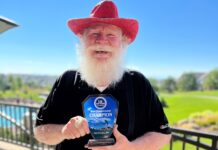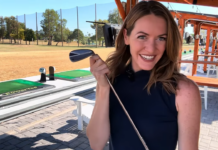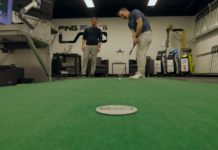Improving your golf game this offseason takes a lot of hard work, practice and patience. So create purposeful practice to pay dividends in 2016.
By Jon Levy
First off, Mr. or Ms. Devoted Golfer, congratulations for committing to improve your game this offseason!
 There’s nothing like seeing the fruits of your labor translate into long drives and more birdies to truly epitomize why you caught the golf bug in the first place.
There’s nothing like seeing the fruits of your labor translate into long drives and more birdies to truly epitomize why you caught the golf bug in the first place.
But, as you’re making good on the pledge to grind away all winter, how you answer the following question could mean all the difference between a bust-out year of improvement in 2016, or somewhat of an improvement bust.
So, without further ado … are you a floater or a swimmer?
In other words, are you someone who spends countless hours practicing, but with no method to the madness other than thinking improvement comes from your blistered hands? Or are you someone with a calculated, thought-out plan to maximize every minute of the process?

After years of hindsight as a former college golf coach with perspective on my own career, I realized I was a “floater” – one who accrued hundreds of reps during a given practice session of whatever (long game, short game, 300-straight 6-irons), but with no rhyme or reason behind it.
After long sessions I’d often wonder if the improvement was in fact coming, or if I had worked on the correct things, or, sometimes, even if my game had gotten worse from all the hours flailing away!
 If I were instead a “swimmer” – one who’s always moving toward a specific direction, with specific, focused objectives – my efforts would have likely yielded more efficiency and bona fide results every time I stepped out to get my grind on.
If I were instead a “swimmer” – one who’s always moving toward a specific direction, with specific, focused objectives – my efforts would have likely yielded more efficiency and bona fide results every time I stepped out to get my grind on.
Here’s why:
But, let’s first note this is NOT to say repetition in itself is a bad thing – there’s a reason famous workhorses on the range like Hogan, Player and Woods became so successful, and it often takes A LOT of reps to hone your skill.
It’s rather the type of repetition that can make all the difference in the world.
So, to make sure you’re maximizing your effectiveness when practicing, two key elements should reign true every time you tip over the bucket and go to town:
1. Frequently vary club choice and shot type.
Ever drive on a long road trip and “space out” for a while, to then all of a sudden realize you can’t remember the last 50 miles of your life?
 The same thing can occur with mindlessly hammering away on the range, so a good way to avoid this is by frequently changing clubs and the type of shots you hit.
The same thing can occur with mindlessly hammering away on the range, so a good way to avoid this is by frequently changing clubs and the type of shots you hit.
For example, within your 90-ball bucket, you could switch clubs, say, every five shots – perhaps moving from the 7-iron to hybrid to wedge to driver and so on – all while going for different trajectories and shot shape to keep things constantly fresh and varied.
You’ll still get the reps you need, but your mind stays engaged and you’ll avoid the rut of going through the motions. And you’re also more directly emulating the flow of a real round of golf, which is an equally-important part of the equation.
2. Create focused, specific objectives for every shot.
Have a favorite drill like the Ping Pong Drill? Are you dying to nail that high draw? Do you enjoy visualizing those two spaced-out trees in the distance as the fairway cut on your one nemesis hole out there?

These are just a few examples of how to narrow your focus and practice more effectively, but the takeaway here – along with varying your routine – is that you should create specific objectives with every shot to avoid the mindless grind.
This could mean five-straight shots working on your drill before another five “normal” shots, or five attempts at the high draw before five with a low fade, or making yourself hit that visualized-fairway five times in a row before you leave the range.
Again, how may you choose to effectively focus in this regard is not as important as the act of focusing in itself, so really put an effort toward maintaining this targeted attention for the duration of each practice session.
Focused, but not rigid.
Building your practice sessions around a targeted, “swimming” approach doesn’t mean you have to ALWAYS have hit 30 total balls doing X and another 30 doing Y – your routine and session objectives can change from day to day with different drills, learning new and different types of shots, and creating range games like the visualized fairway or putting green games like holing a set number of putts from a set distance before your session is complete … your choices are nearly endless and it can be fun to explore different games and routines.
So, be focused, not rigid, and find what’s most effective for you, the time you have allotted, and what you realistically hope to hone each session.
Because, after all, you’ve committed to improve greatly this offseason, so you might as well swim directly toward your goal instead of wasting a single second floating back in the current to nowhere.










